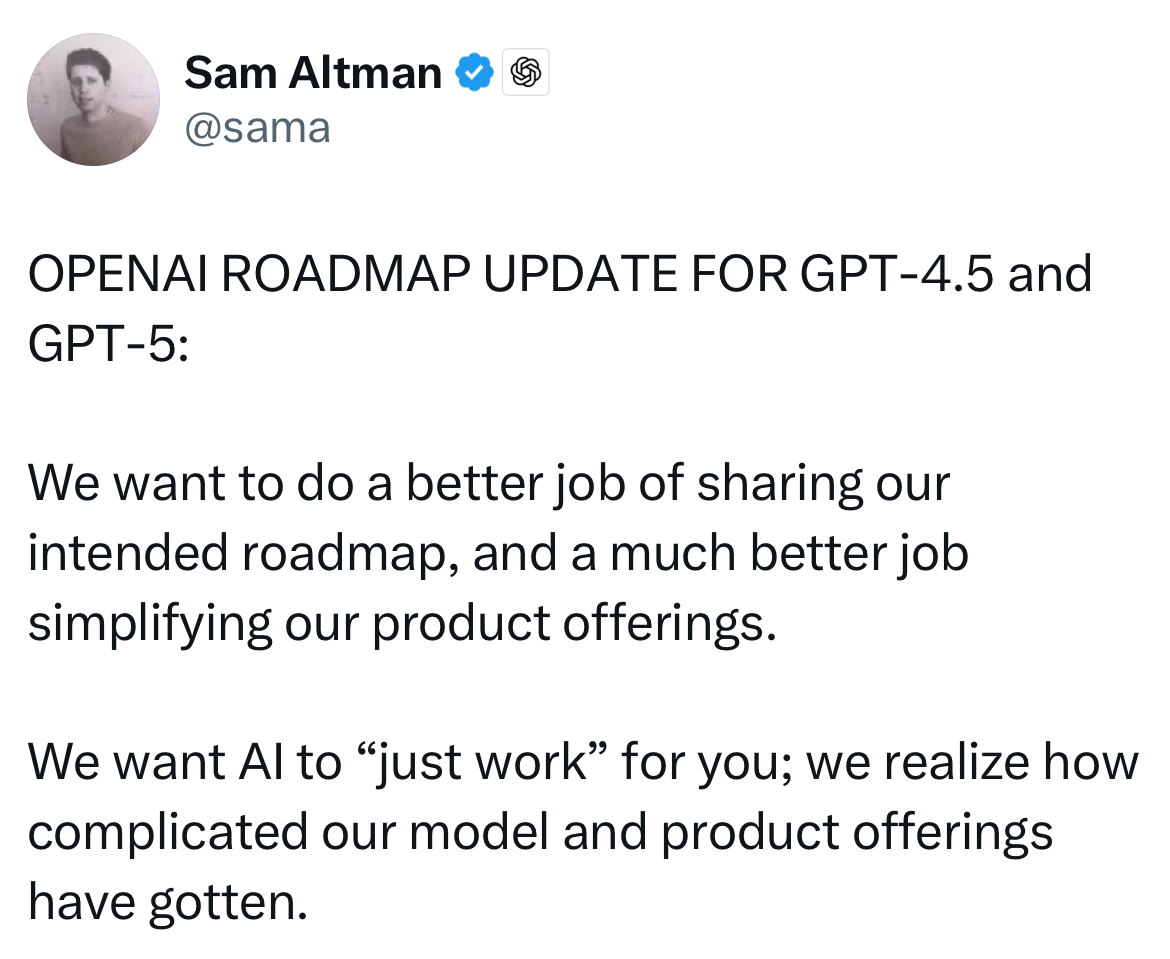Table of Contents
OpenAI’s CEO Sam Altman recently announced exciting updates to its product roadmap, aiming to streamline its offerings and deliver a more cohesive, user-friendly AI experience. In a series of tweets, Altman outlined plans for GPT-4.5 and GPT-5, emphasizing the company’s commitment to unifying its technologies and eliminating complexity. The updates reflect OpenAI’s mission to make AI “just work” for users, moving away from fragmented tools and toward a single, adaptable system.
Key Announcements
- GPT-4.5 (“Orion”)
GPT-4.5, internally codenamed Orion, will be OpenAI’s final standalone model that does not use chain-of-thought reasoning—a technique where AI breaks down problems step-by-step, mimicking human problem-solving. This model bridges the gap between older systems and the next-generation GPT-5, offering improved accuracy and efficiency for tasks requiring straightforward solutions. - GPT-5: A Unified AI System
The flagship GPT-5 will integrate OpenAI’s entire suite of tools, including the o-series models (specialized systems like code generators or research assistants) and the core GPT architecture. Unlike previous models, GPT-5 will dynamically decide when to “think” deeply versus providing quick answers, optimizing performance for both simple queries and complex tasks.
- Discontinuing Standalone Models: The o3 model, part of the o-series, will no longer be offered as a standalone product. Instead, its capabilities will be baked into GPT-5.
- Multimodal Features: GPT-5 will incorporate voice interaction, visual tools (like a canvas for brainstorming), real-time web search, and deep research capabilities for synthesizing large datasets.
Subscription Tiers and Access
OpenAI is revamping its ChatGPT tiers to align with GPT-5’s rollout:
- Free Tier: Unlimited access to GPT-5 at a “standard intelligence” level, with safeguards against abuse.
- Plus Subscribers: Higher intelligence settings, enabling more nuanced reasoning and creativity.
- Pro Subscribers: Top-tier access with priority features, including advanced research tools and faster response times.
Sam Altman acknowledged user frustration with the current “model picker” interface, which forces users to manually select tools. GPT-5’s unified design aims to eliminate this friction, automatically selecting the best approach for each task. In response to a user question about timelines, Altman clarified that GPT-4.5 and GPT-5 are expected to launch within “weeks to months”—a timeframe reflecting OpenAI’s focus on rigorous testing and gradual deployment.
Future Goals
OpenAI’s long-term vision centers on creating AI that adapts seamlessly to diverse needs:
- Unified Systems: Merging specialized models (e.g., coding, translation) into a single framework.
- Dynamic Problem-Solving: GPT-5 will decide whether to deliver instant answers or spend computational resources on deeper analysis, depending on the task.
- Ethical Simplicity: Reducing complexity not only improves usability but also mitigates risks like bias or misuse, as a unified system is easier to monitor and refine.
Why This Matters
These updates signal a shift from toolbox AI to general intelligence. By unifying models, OpenAI aims to create systems that feel less like machines and more like collaborators—capable of handling everything from casual conversation to technical research without requiring users to toggle between modes. For developers and everyday users alike, this means faster, more intuitive interactions with AI.
Artificial General Intelligence (AGI) represents a new era of artificial intelligence (AI), where a machine will be able to mirror human-like intelligence and also have the ability to self-teach. The type of AI that is the most prevalent today is narrow AI. While Narrow AI systems are designed for specific tasks such as language translation or image recognition, the goal of AGI is to essentially perform any task as well as a human being can.
Learn more about general intelligence here.
OpenAI’s roadmap underscores its ambition to democratize advanced AI while maintaining ethical guardrails. As GPT-4.5 paves the way for GPT-5, the company is betting on unification and simplicity to unlock AI’s full potential. For users, the promise is clear: fewer buttons to press, fewer models to choose from, and more magic in every interaction.

